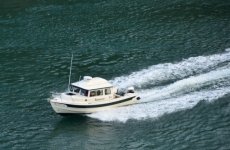Tom:
A year or so ago, when the Army Corp of Engineers made it clear that they no longer had the money to take care of dredging the Swin. Channel, The Port of Skagit hired a hydraulic engineering firm to study the siltation problem. The report is in the public domain, and would be available to anyone requesting it from the Port.
In summary however, it said this:
The channel has always had a problem with siltation, primarily from sand coming down the Skagit River from the Mt. Baker watershed and has required dredging every 2 - 3 years since it was constructed nearly 100 years ago. For most of that time it has required dredging every 2 - 3 years in order to accommodate a 12 foot draft at mean low tide.
The overall rate siltation averages about 1 foot per year, but there are 3 areas where due to their peculiar hydraulics the rate may be much greater. On the south end, they are near the "Eye of the Needle" particularly on the east side. Northbound from there, on the west side near the entrance to Shelter Bay, and finally just outside of the RR bridge on the far north end. Further, because the material is sand in a moving body of water, the shallow areas move around a bit from time to time, making accurate prediction of their location difficult, i.e. on one trip there is no problem, on the next there is.
The Port of Anacortes dredged the far north end last year up by the RR bridge in order to use the material as fill, and since then it has seemingly been OK for most vessels. This is not necessarily so for the two areas further to the south.
Knowing all this, when I go through the channel I avoid the shoreline near Shelter Bay, and really slow down once I get near the Eye of the Needle. From there I really try to stick to mid channel all the way to the far markers at the exit of the channel on the far west side. If you run that portion at very low tide sometime, it will surprise you how narrow it really is.
The tug operators who use the channel all the time get to be like Mark Twain style river boat pilots in their knowledge of where the shallow water is, and therefore generally do not have much of a problem.
Luckily, should a mishap occur, the material is pretty clean sand rather than rock, so vessels that have enough draft to likely go aground generally have a pretty gentle experience. Usually these are vessels of more than 4 - 5 foot of draft, who for whatever reason were navigating in locations everyone else knew enough to avoid.
With a recent (and unexpected) federal waterways grant of about $2,000,000, plus some local tax contributions, the needed dredging should ultimately be taken care of, at least for the next several cycles. However, the dredging process itself requires an interminable series of permit approvals from all kinds of government agencies, and so is not likely to begin until later in the year.
At one time I was running a Nordhavn 46 through the channel and then out through Deception Pass year round on a fairly regular basis. This caused me a lot more consternation than now when running lighter outboard powered boats. With the Tom Cat (or our previous Sea Sport) given a little caution I really do not consider the channel or for that matter Deception Pass much of a problem in most conditions.
Kevin E. Ware

